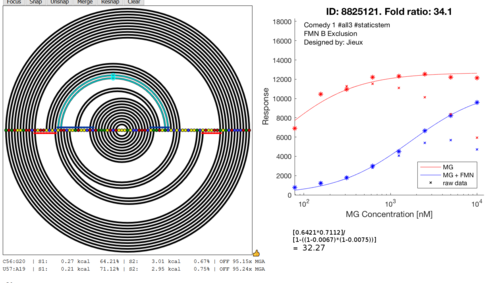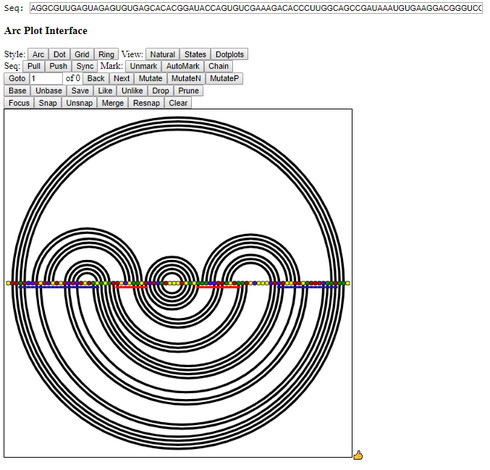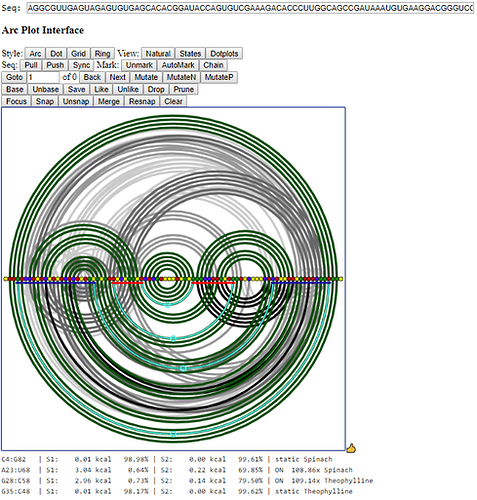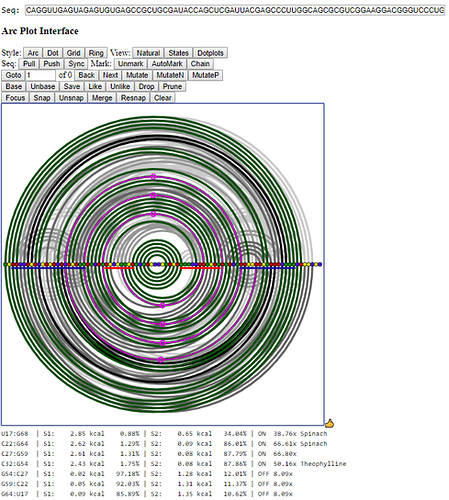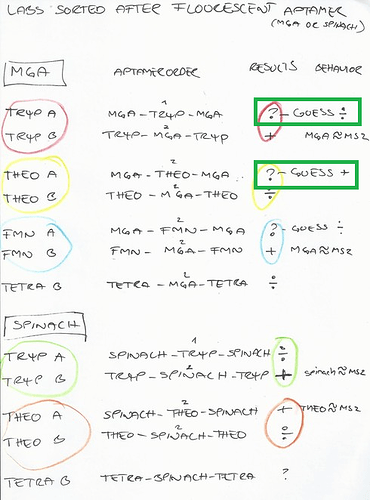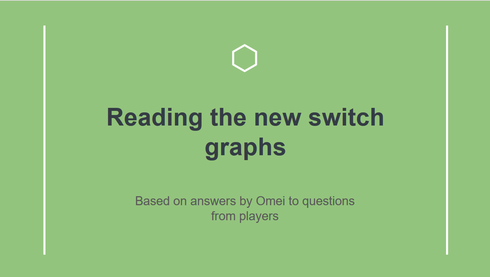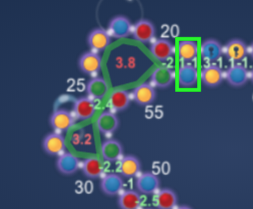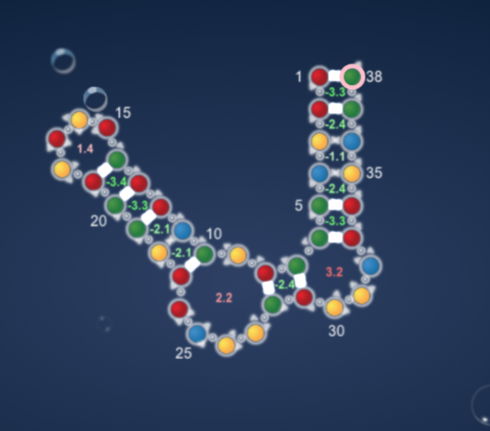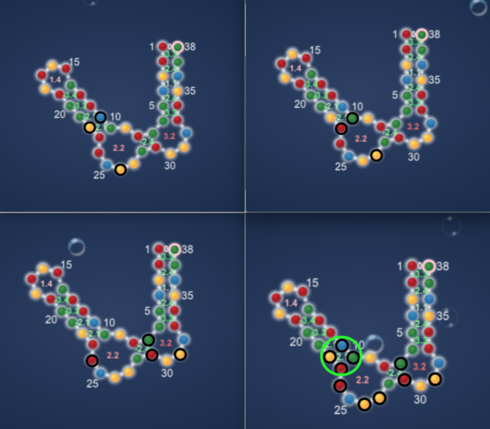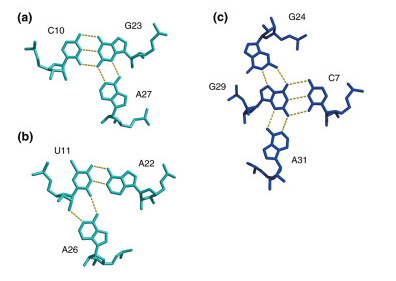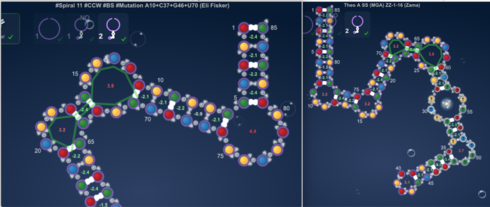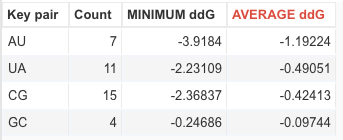Here is a document with filtered Theophylline B Same State (MGA) designs:
Hi Zama, the way I did it before wouldn’t apply to exclusion puzzles, because what I’m doing is averaging out the results for the probability of one specific structure forming.
So what the Folding Ratio from the real life experimental results tells us is the folding ratio of the MGA loop forming in one state and not the other, it doesn’t demonstrate anything else, so if you were to apply what I’m doing to Jieux’s puzzle, you would look at non-static MGA bonds and apply the following, regardless of any other structure forming.
I haven’t tested this hypothesis too much, but for the few things I have it’s worked out well, I’ll work on my theory some more
Yes, thank you for the explanation and visual. I knew the off would be different, but now I see where you’re getting your numbers.
Here’s my predictions for the Round 5 results for anyone who’s interested:
Theophylline A Same State (Spinach):
Astros-Modly-mod3 (Astromon) 29.24
JanderMod 10 #all3 #staticstem - Jieux - Theophylline A Same State (Spinach) (Jieux) 24.81
TheoASS-SPIN-68 (Poll na gColm) 1.62
Theophylline A same Spinach 62 (dl2007) 14.45
JR_TheoASS(Spin)_Sub00102 (JR) 40.67
Theophylline B Same State (Spinach):
Astros-thepienspinack (Astromon) 9.77
Theophylline B same Spinach 69 (dl2007) 0.66
Thepienspinack mod A #spiral #mirrored_arcplo (Omei) 1.40
#Outsideaptamerturnoff 2 (Eli Fisker) 1.54
JRmod 10 #all3 #proximitylocked #staticstem - Jieux - Theophylline B Same State (Spinach) (Jieux) 1.0
JR_TheoBSS(Spin)_Sub005 (JR) 8.87
finding some bugs in some of the metrics code, so my recommendations may change.
spirals have nothing to do with anything. focus on the faint (possible but unlikely) bonds
Here is some analysis in relation to our new results for lightning round 5 that got shared in the news post Lightning round 5 results.
Omei was wondering about why the Theophylline B Same State (Spinach) lab went bust, while the Theophylline A Same State (Spinach) lab went great.
I think I have an explanation.
A or B puzzle type?
A pattern that has been there from our recent lab with a reporter against an aptamer is the following:
When there are two partner labs, where the only difference is that the order of the reporter and the aptamer have position swapped for each other, then one of these partner labs tend to do a lot better than the other. There is an optimal order of aptamer and reporter in relation to each other.
In the R107 lab Single-input switches, revisited we had a lab round that looked at the MS2 reporter against a bunch of aptamers that were mostly new to us.
The aptamers were Tryptophan, Theophylline and Argenine. That lab too introduced the puzzle type naming A or B - in relation to if the MS2 sat outside of the aptamer. (A type) or if the MS2 sat between in between a split version of the aptamer.
Earlier we also had the R101 lab FMN/MS2 Riboswitch Structure. Those puzzle types weren’t named A and B type. But what pattern has showed itself in relation to MS2 so far is that the B puzzle type generally has performed better than the A type. The pattern has been present from the earliest FMN/MS2 switches.
So Aptamer-MS2-Aptamer labs tends to go better than MS2-Aptamer-Aptamer.
Explanation to the image
The numbers 1 or 2 over the middle aptamer section signify if the aptamer is in one whole piece or if it is split.
The behaviour column where I have put MS2 equivalent to different aptamers, I’m basically stating which aptamer that takes the strongest aptamer spot, where MS2 would normally like to be if it was a part of a riboswitch.
!(https://d2r1vs3d9006ap.cloudfront.net/s3_images/1759825/RackMultipart20181031-24889-13zq21d-Labs_sorted_after_flourescent_aptamer MGA_or_Spinach inline.jpg?1540991332 “Image httpsd2r1vs3d9006apcloudfrontnets3_images1759825RackMultipart20181031-24889-13zq21d-Labs_sorted_after_flourescent_aptamer__MGA_or_Spinach__inlinejpg1540991332”)
Relative strength of aptamers in relation to each other
However now we are trying a bunch of relatively new aptamers to us, plus some new reporters. For these new aptamers I have mentioned that we still don’t know which of them are strongest. As opposed to eg MS2 and FMN. In past labs MS2 has been pretty strong and rather stuborn, so that it took a good bunch of bases to make it turnoff.
I have expected the stronger aptamer/reporter to take the spot of MS2 - in the middle between the sequences of the other aptamer.
Future prediction
I will take a stab at future prediction for the fate of a couple of the labs that we don’t have results on yet. I will base my guess on the result from their partner lab. The lab that has the same flourescent aptamer, but is of the opposite puzzle type. (A versus B type)
- Since Tryptophan B SS (MGA) went well, I guess that Tryptophan A SS (MGA) will go less well
- Since Theo B SS (MGA) went bad, I guess that Theo A SS (MGA) will go well
- Since FMN B Exclusion (MGA) went well, I guess that FMN A Exclusion (MGA) will go less well
If we are to do more lightning round labs before the full lab round, then I propose Theophylline A Same State (MGA) as candidate as I expect it to do well.
Request of extra lab puzzles
The Tetracycline Same State B (MGA) lab went bad. (Tetracycline-MGA-Tetracycline) But we never had its partner lab Tetracycline Same State B (MGA). (MGA-Tetracycline-MGA)
Provided that it is possible to make the partner tetracycline lab, I excect based on the result so far, that it should do better than the one we have done.
Basically I wish that we have a full set of partner labs for all the labs we have been working with so far.
I did a summary of the lab with the two good designs in the lightning round 5 labs. Theophylline A Same State (Spinach) https://eternagame.org/game-legacy/browse/8789144/
I have noted that the two great designs, the one by Astromon and the one by JR both follow previous lab trends.
JR’s good design is of the circularized arc plot kind - in this case looking like a clown mouth in natural view.
It is if the symmetric RNA origami style - making a switching movement typical of the majority of past winners. Plus both aptamers have static ends. Weird enough this circularized design has a similar switch graph as the spirals generally seem to have.
Astromon’s good design is of the spiralized arc plot kind. It has an aptamerselfturnoff for the theophylline aptamer. Plus just as the 2 best designs in Tryptophan B Same state Spinach both of it’s aptamers have one static end.
Theophylline A Same State (Spinach) summary
- Astromon (9019376) #Spiral #ccw #bs #aptamerselfturnoff #two static aptamer ends
- Jieux (8895380) #spiral #ccw #SB
- Poll na gColm (9026438) #spiral #ccw #sb
- Dl2007 (8978861) #spiral #CW #BS
- JR (8803108) #BS #symmetric Circularized arc plot #two static aptamer ends
Word explanation
#CCW - counterclockwise spiral
#CW - clockwise spiral
#BS - big side of aptamer first, small side later (for spinach or MGA)
#SB - small side of the aptamer first, big side later (for spinach or MGA)
+/- - weather the design did well or not
eli, i need to speak with you
I have a couple notes to add. Neither of these two winners forms the same shape in all three engines, whereas I’ve noticed our best winners hold their shape fairly consistently across all three engines. I’ve noticed this is fairly rare in my limited experience.
All our Lighting Round winners have at least one loop in state 1. Even if the loop is small, perhaps the unpaired bases provide a weak spot where the molecule can separate to fold into state 2.
And static stems work once again. I’m guessing these add stability to the shape and provide a foundation for each aptamer so that the aptamers don’t have to form completely out of nowhere.
Sorry if I’m repeating the obvious. Feel free to fill me in!
Benbennett1, do speak.
DigitalEmbrace, thx for your notes.
“And static stems work once again. I’m guessing these add stability to the shape and provide a foundation for each aptamer so that the aptamers don’t have to form completely out of nowhere.”
I think this is exactly why.
Keep an eye for a continuation of your 1 loop in state 1 idea. Do this loop turn up somewhere specific? What I’m wondering is if there is any pattern?
I filtered the so far submitted Tetracycline B Same State (Spinach) designs. Here is a document with arc plots of the resulting designs.
Thank you, Eli! The multi-looped tetracycline aptamer with hairpin sure does mix-up the look of things.
Np, Zama! I was happy to see that there were even a bunch of spirals among.
I have managed to find, mood or make 3 of 4 spiral types. #cw #bs, #cw #sb and #ccw #sb. I haven’t managed to find or make #ccw #bs yet.
Here is an additional document with a filtered set of designs from the FMN A Exclusion lab. I added stronger filter conditions as I ended up with more than 200 designs after my first filtering.
Here are my top picks for Tetracycline B (Spinach), mostly based on clean arcplots, high state 2 percentage/ratio, and low d1/d2. Several successful designs in the Lightning Rounds have an internal loop in the switching section in state 1, so the first two feature internal loops.
https://eternagame.org/game/browse/8789146/?filter1=Id&filter1_arg1=9080889&filter1_arg2=9080889
https://eternagame.org/game/browse/8789146/?filter1=Id&filter1_arg1=8837593&filter1_arg2=8837593
https://eternagame.org/game/browse/8789146/?filter1=Id&filter1_arg1=9082875&filter1_arg2=9082875
https://eternagame.org/game/browse/8789146/?filter1=Id&filter1_arg1=9072266&filter1_arg2=9072266
https://eternagame.org/game/browse/8789146/?filter1=Id&filter1_arg1=9081765&filter1_arg2=9081765
https://eternagame.org/game/browse/8789146/?filter1=Id&filter1_arg1=9056679&filter1_arg2=9056679
A and B type lab predictions holds up
Recently I made a prediction for the few labs that we still hadn’t done lightning rounds in from the Lighting Up Dark Cell’s round.
Now we have gotten results back from two of these labs where I made guesses. Tryptophan A Same State (MGA) and Theophylline A Same State (MGA)
- Theophylline A MGA had good difference between the blue and red curves in several switch graphs.
- Tryptophan A MGA had only really minor difference between the blue and red curves in some of the switch graphs.
Reading the new switch graphs
While the scoring scheme for the new switch graphs is still in the making and things as such are not set in stone yet, there are still things that can help us with deciphering the switch graphs.
Omei was answering switch graph reading questions.
Looking over the lightning round results, I noticed that on the whole, we have done considerably better with the Spinach aptamer than the MGA one. So I looked over some of the better MGA designs, like this one from the first round (Jieux’s Comedy 1 #all3) to see if there was anything in common among those that did switch .
The first three I found all shared the characteristic of having an AU pair next to the larger of the aptamer loops
A quick check showed that this particular choice of pairs was not that common, and I wondered if there might be something in the scientific literature that could account for how an AU pair here could influence the binding. I found three experimental papers about the aptamer. It turns out that the bulk of the experimental data has been done on this hairpin sequence, with minor variations.
(Note that the base pair 11-22 corresponds to the highlighted pair above.)
The three dimensional structure of this aptamer binding to the malachite green molecule has been determined, and it is very unusual. The bound aptamer is stabilized by two base triples and one base quadruple. The first three panes of the diagram below mark the bases involved in these structures.
What is happening is that the RNA backbone at base 25 actual makes a U-turn, allowing base 26 to reinforce the pair U10-A23 and 27 to reinforce the pair C10-G23. Here’s the 2D structure of the 3 reinforcing structures. (This figure comes from a paper that used a triloop hairpin instead of a quad loop , so the base numbers over 19 are shifted by one.)
Furthermore, the AUA triple has been shown to be very important for the stability of the binding pocket. Reducing the triple to a normal Watcon-Crick pair by mutating base A26 (A27) reduces the binding energy of the aptamer by 2.5 to 3 kcal, essentially eliminating its affinity.
Unfortunately, the question of most importance to us (should be always design with the AU pairing at this position, or are others just as good?) isn’t specifically addressed in the scientific literature. There is a possibility that pairs other than the AU can form the same, or similar, triples. But the lightning rounds have given us results on 42 MGA designs that we can compare. Those results suggest that the AU pair is an especially good choice. Because there are differences among the rounds, there doesn’t seem to be a unique way to make the comparison, but here is an obvious one.
Of the 42 MGA designs, only seven (17%) have used an AU pair in the same orientation as above. But of the six best fold ratios (> 2.6), four (67%) have used the AU pair.
I intend to follow up on this over the next day or two, but I wanted to post this much now. The current lightning round is using MGA. and it seems that the choice of bases at this position should be a significant factor in both designing and voting.
Following up on the above, I categorized each of the designs tested so far that used the MGA aptamer by the next-to-closing base pairs, i,e, 11 and 22 in the above screen shots. But before showing that table, I want to clarify what I mean by an AU pair vs a UA pair.
The pair I am always referring to is the next-to-closing pair of the bigger aptamer loop – bases 10 and 70 on the left and bases 59 and 27 on the right. (Regardless of the orientation of the aptamer, the stem base next to the closing G will always have a number one less than the G and the stem base next to the closing C will have a number one more than the C .) When I categorise a pair, I will put the base next to the G first. Thus, the next-to-closing pair in the design on the left is AU. On the right, it is UA.
For the purpose of calculating a summary statistic for a group of designs, one can’t meaningfully average fold ratios. But the fold ratio can be converted to an energy value (called ddG) by taking its logarithm, and it is appropriate to average energy values.
So here’s the average energy difference between states 1 and 2, grouped by next-to-closing pairs of the big end of the MGA aptamer. (I have omitted the UG and GU pairs because there was only one instance of each, and the values were unexceptional.)
This indicates that in the designs tested so far, the AU pair retains its advantage over others when considering all the designs, good or bad. As far as interpreting the significance of the ddG values, the difference between the ddG values for AU and UA (0.7) corresponds to slightly more than a doubling of the fold change.
